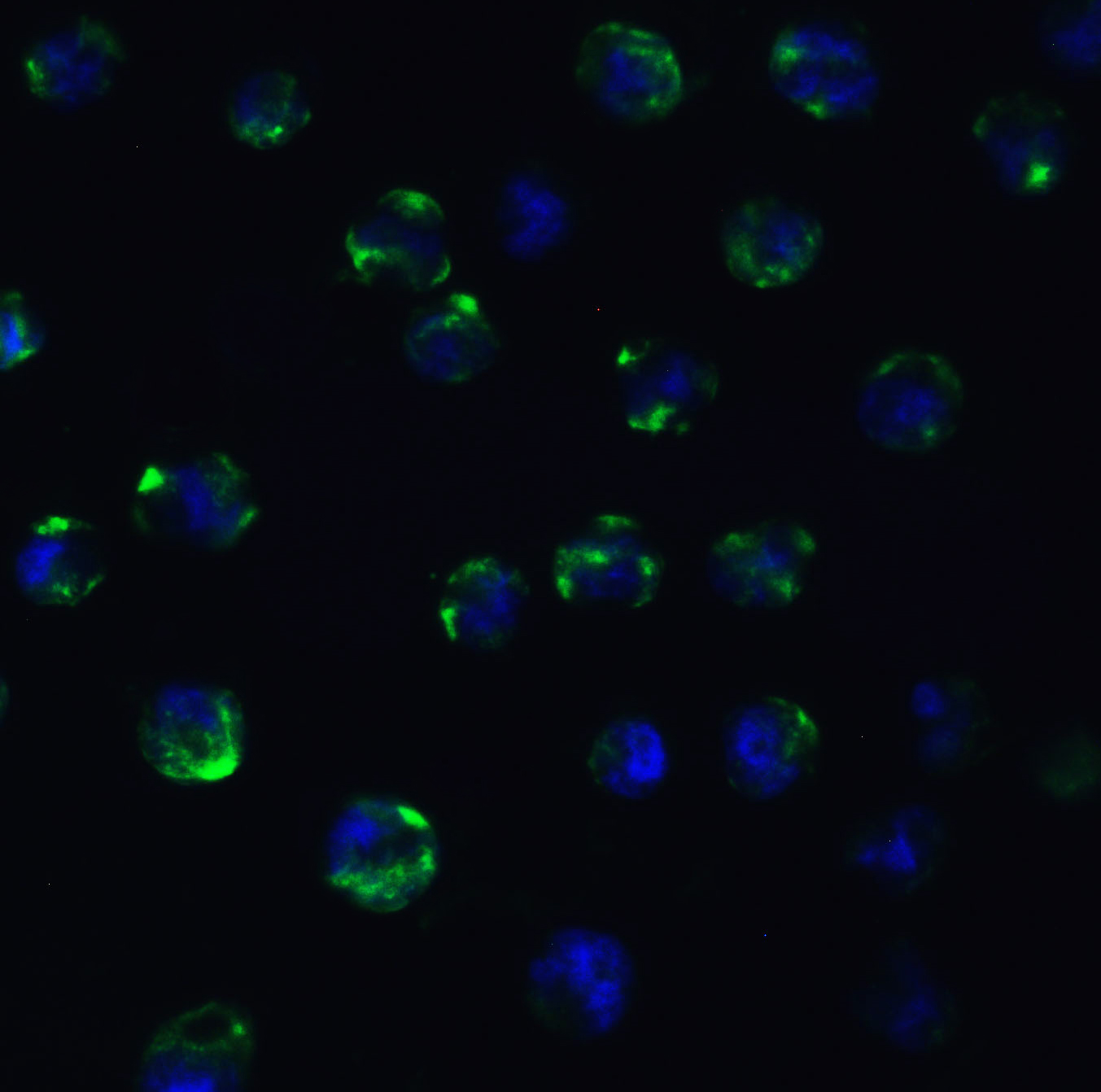Anti-ADAM10 /KUZ /MADM Antibody (2051)
$445.00
| Host | Quantity | Applications | Species Reactivity | Data Sheet | |
|---|---|---|---|---|---|
| Rabbit | 100ug | ELISA,WB,ICC,IF | Human, Mouse, Rat |  |
SKU: 2051
Categories: Antibody Products, Apoptosis Antibodies, Products
Overview
Product Name Anti-ADAM10 /KUZ /MADM Antibody (2051)
Description Anti-ADAM 10 (CT) Rabbit Polyclonal Antibody
Target ADAM10 /KUZ /MADM
Species Reactivity Human, Mouse, Rat
Applications ELISA,WB,ICC,IF
Host Rabbit
Clonality Polyclonal
Isotype IgG
Immunogen Peptide corresponding to aa 732-748 of human ADAM10. This sequence is identical to those of bovine and rat and differs from mouse by one amino acid.
Properties
Form Liquid
Concentration Lot Specific
Formulation PBS, pH 7.4, 0.02% sodium azide.
Buffer Formulation Phosphate Buffered Saline
Buffer pH pH 7.4
Buffer Anti-Microbial 0.02% Sodium Azide
Format Purified
Purification Purified by peptide immuno-affinity chromatography
Specificity Information
Specificity Human. In immunoblots a band of 85kDa is detected and may represent precursor. Lower mw bands are detected in some cell lines, including Jurkat, and may represent the processed mature protein.
Target Name Disintegrin and metalloproteinase domain-containing protein 10
Target ID ADAM10 /KUZ /MADM
Uniprot ID O14672
Alternative Names ADAM 10, EC 3.4.24.81, CDw156, Kuzbanian protein homolog, Mammalian disintegrin-metalloprotease, CD antigen CD156c
Gene Name ADAM10
Gene ID 102
Accession Number NP_001101
Sequence Location Cell membrane, Golgi apparatus membrane, Cytoplasmic vesicle, clathrin-coated vesicle, Cell projection, axon, Cell projection, dendrite, Cell junction, adherens junction, Cytoplasm
Biological Function Cleaves the membrane-bound precursor of TNF-alpha at '76-Ala-|-Val-77' to its mature soluble form. Responsible for the proteolytical release of soluble JAM3 from endothelial cells surface (PubMed:20592283). Responsible for the proteolytic release of several other cell-surface proteins, including heparin-binding epidermal growth-like factor, ephrin-A2, CD44, CDH2 and for constitutive and regulated alpha-secretase cleavage of amyloid precursor protein (APP) (PubMed:26686862, PubMed:11786905, PubMed:29224781). Contributes to the normal cleavage of the cellular prion protein (PubMed:11477090). Involved in the cleavage of the adhesion molecule L1 at the cell surface and in released membrane vesicles, suggesting a vesicle-based protease activity (PubMed:12475894). Controls also the proteolytic processing of Notch and mediates lateral inhibition during neurogenesis (By similarity). Responsible for the FasL ectodomain shedding and for the generation of the remnant ADAM10-processed FasL (FasL APL) transmembrane form (PubMed:17557115). Also cleaves the ectodomain of the integral membrane proteins CORIN and ITM2B (PubMed:19114711, PubMed:21288900). Mediates the proteolytic cleavage of LAG3, leading to release the secreted form of LAG3 (By similarity). Mediates the proteolytic cleavage of IL6R and IL11RA, leading to the release of secreted forms of IL6R and IL11RA (PubMed:26876177). Enhances the cleavage of CHL1 by BACE1 (By similarity). Cleaves NRCAM (By similarity). Cleaves TREM2, resulting in shedding of the TREM2 ectodomain (PubMed:24990881). Involved in the development and maturation of glomerular and coronary vasculature (By similarity). During development of the cochlear organ of Corti, promotes pillar cell separation by forming a ternary complex with CADH1 and EPHA4 and cleaving CADH1 at adherens junctions (By similarity). May regulate the EFNA5-EPHA3 signaling (PubMed:16239146). {UniProtKB:O35598, PubMed:11477090, PubMed:11786905, PubMed:12475894, PubMed:16239146, PubMed:17557115, PubMed:19114711, PubMed:20592283, PubMed:21288900, PubMed:24990881, PubMed:26686862, PubMed:26876177, PubMed:29224781}.; (Microbial infection) Promotes the cytotoxic activity of S.aureus hly by binding to the toxin at zonula adherens and promoting formation of toxin pores. {PubMed:20624979, PubMed:30463011}.
Research Areas Apoptosis
Background TNFalpha, Notch and its ligand delta are all membrane-bound molecules which are cleaved by proteases to release mature proteins or functional receptors. ADAM10, a metalloprotease- disintegrin in the family of mammalian ADAM (for a disintegrin and metalloprotease) was recently found to cleave TNFalpha, Notch and its ligand delta. The genes encoding human, mouse, and bovine ADAM10 have been cloned and designated ADAM10, Kuzbanian (KUZ), and MADM, respectively. These genes are expressed in a variety of human and bovine tissues.
Application Images


Description Immunofluorescence of ADAM10 in K562 cells with ADAM10 antibody at 10 ug/mL.
Handling
Storage This antibody can be stored at 4°C for three months and for one year at -20°C. Store product in appropriate aliquots to avoid multiple freeze-thaw cycles.
Dilution Instructions Dilute in PBS or medium that is identical to that used in the assay system.
Application Instructions Immunoblotting: use at 1- 10ug/mL.
Immunofluorescence: use at 10ug/mL.
Immunocytochemistry: use at 2ug/mL.
Endusers should determine optimal concentrations for their applications.
Immunofluorescence: use at 10ug/mL.
Immunocytochemistry: use at 2ug/mL.
Endusers should determine optimal concentrations for their applications.
References & Data Sheet
Data Sheet  Download PDF Data Sheet
Download PDF Data Sheet
 Download PDF Data Sheet
Download PDF Data Sheet

